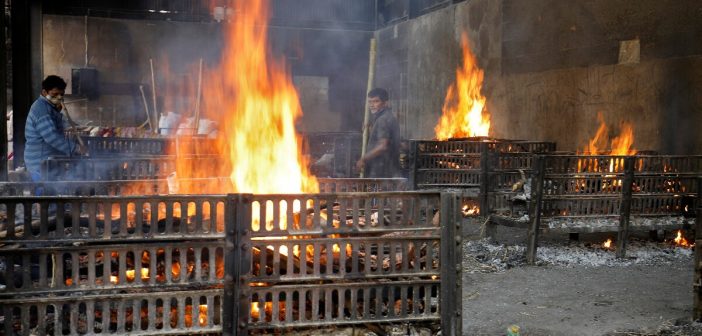The solemn rituals of cremation, a deeply ingrained practice within Hindu and other religious traditions in India, are increasingly clashing with the realities of rapid urbanization. As India’s cities expand, traditional crematoriums that once existed on the outskirts are now finding themselves surrounded by residential neighborhoods, raising concerns about the impact on property values and the quality of life for those living nearby.
The Price of Proximity
While the spiritual significance of crematoriums is undeniable, potential homebuyers are increasingly apprehensive about living in close proximity to these facilities. Several factors contribute to this perception:
- Smoke and Air Quality: The smoke emanating from cremations can lead to unpleasant odors and concerns about potential health impacts due to particulate matter and other pollutants released into the air.
- Noise Pollution: The sounds associated with the cremation process, including the crackling of wood and occasional chanting, can be a source of disturbance for residents, especially during the quiet hours of the night.
- Psychological Impact: For some, the constant reminder of mortality and the sight of funeral processions can evoke feelings of unease and negativity.
- Superstitions and Cultural Beliefs: Certain superstitions and cultural beliefs surrounding death and cremation can create a perception of inauspiciousness associated with living near these facilities.
Research examining property prices near crematoriums supports these concerns. A study conducted in the city of Hyderabad found that properties within a 500-meter radius of a crematorium saw an average decrease in value of up to 10% compared to similar properties further away. Similar trends have been observed in other Indian cities.
The Social Cost: Discomfort and Disputes
Beyond the financial implications, the proximity of crematoriums to residential areas can lead to social tensions and disputes. Residents may express concerns about health hazards, noise levels, and the emotional impact of living near a place of mourning, leading to conflicts with crematorium authorities. These disputes can create a stressful environment for both residents and those seeking to perform the sacred rites of cremation for their loved ones.
Seeking Solutions: Balancing Tradition and Urban Development
Addressing this sensitive issue requires solutions that acknowledge the cultural importance of cremations while mitigating the negative impacts on surrounding communities:
-
Relocation and Planning: In densely populated cities, relocating existing crematoriums to less inhabited areas may be considered. For new crematoriums, careful urban planning can ensure these facilities are established in locations that minimize their impact on residential neighborhoods.
-
Modernization and Pollution Control: Upgrading crematoriums with modern technologies such as electric furnaces or advanced filtration systems can significantly reduce smoke emissions and mitigate air pollution concerns.
-
Green Buffers: Creating green buffers of trees and vegetation around crematoriums can help absorb pollutants, reduce noise levels, and provide a sense of visual separation for nearby residents.
-
Community Engagement and Dialogue: Open communication between crematorium authorities and local residents is crucial for addressing concerns, building mutual understanding, and finding solutions that work for the community as a whole.
-
Changing Perceptions: Sensitizing the public about modern cremation practices and the importance of pollution control measures can help dispel undue fears and promote acceptance of crematoriums as a necessary part of urban life.
Striking a Balance
India’s rich cultural heritage and the realities of modern urban life present complex challenges. The issue of crematoriums in cities highlights the need for a delicate balance between respecting age-old traditions and ensuring the well-being and quality of life for urban residents. By implementing thoughtful planning, technological advancements, and open communication, India can navigate this sensitive issue in a way that safeguards the sanctity of cremation rituals while minimizing the negative consequences for those living nearby.
Challenges and Considerations: Finding the Path Forward
While the proposed solutions offer a framework for mitigating the impact of crematoriums on property values and communities, several challenges require careful consideration:
Cost and Implementation: Upgrading crematoriums with advanced technology or relocating them to new locations can be expensive undertakings, requiring significant investment and infrastructure development. Balancing these costs with the economic benefits of maintaining property value and the well-being of residents requires careful planning and financial strategy.
Social Acceptance: While community engagement is crucial, garnering widespread acceptance for relocating existing crematoriums or establishing new ones in certain areas can be challenging. Religious and cultural sensitivities, as well as potential resistance from existing residents, need to be addressed with empathy and understanding.
Land Availability: Finding suitable land for new crematorium locations, especially in densely populated urban areas, can be difficult. Creative solutions like exploring partnerships with existing cemeteries or utilizing public-private partnerships can be explored.
Long-Term Sustainability: Ensuring the long-term sustainability of modern technologies used in crematoriums is crucial. This requires consistent maintenance, proper waste management practices, and ongoing monitoring of air and noise pollution levels.
Shifting Perceptions: Changing deeply ingrained beliefs and superstitions surrounding crematoriums requires a long-term approach. Public awareness campaigns and educational efforts can play a crucial role in fostering understanding and acceptance of modern cremation practices and the positive impact of pollution control measures.
A Collective Effort for a Sustainable Future
Balancing the cultural significance of crematoriums with the needs of urban residents requires a collaborative effort. By acknowledging the challenges, exploring innovative solutions, and engaging in open dialogue with all stakeholders, India can find sustainable ways to manage its crematoriums, ensuring respect for traditions while ensuring a healthy and comfortable living environment for all.
This issue extends beyond the immediate concerns of property values and pollution. It touches upon the core values of a society, requiring sensitivity, respect, and a willingness to find solutions that bridge tradition and the challenges of urban living. By fostering a sense of shared responsibility and collective action, India can navigate this complex issue and create a future where tradition and development coexist harmoniously.






